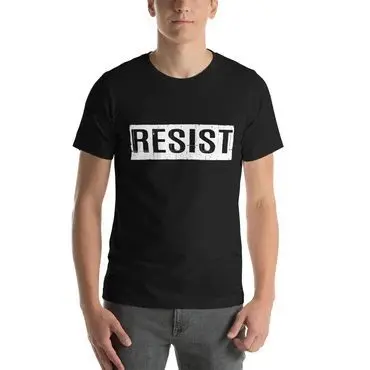By Timothy T. Tater
 In coffee shops from Portland to Paducah and beyond, a quiet revolution is brewing—and it’s wearing a $34.99 mass-produced cotton blend. The “RESIST” t-shirt has become the unofficial uniform of the modern rebel, a declaration that says, “I oppose things, and I want you to know it while I order my oat milk latte.”
In coffee shops from Portland to Paducah and beyond, a quiet revolution is brewing—and it’s wearing a $34.99 mass-produced cotton blend. The “RESIST” t-shirt has become the unofficial uniform of the modern rebel, a declaration that says, “I oppose things, and I want you to know it while I order my oat milk latte.”
These brave fashion warriors have discovered what Che Guevara never could: that true revolution begins at the point of sale. Why storm the barricades when you can storm the clearance rack at Target? The beauty of resistance-wear is its versatility—it pairs equally well with $200 sneakers or a Tesla key fob dangling from organic hemp keychains.
The RESIST shirt serves multiple functions in modern society. It’s a conversation starter (“Oh, what are you resisting?” “You know, just… everything”), a tribal identifier (like a less subtle Patagonia vest), and most importantly, a moral credential that pre-absolves the wearer from having to engage in any actual resistance activities. After all, they’re already doing their part by making their political stance visible from across Whole Foods.
The genius lies in the shirt’s aggressive vagueness. Resist what, exactly? Fascism? Capitalism? Gluten? The beauty is that specificity would require taking actual positions on complicated issues, which might alienate potential followers on Instagram. Better to resist conceptually, atmospherically, hashtag-ically.
Perhaps most remarkably, these shirts have solved the ancient philosophical problem of virtue signaling versus virtue doing. Why choose? Simply purchase virtue, wear it prominently, and let the garment industry handle the heavy lifting of social change. It’s democracy in action—if democracy were a clothing line sold exclusively at Urban Outfitters.
The RESIST movement proves that in America, even rebellion can be commodified, branded, and sold back to us at a reasonable markup. And honestly? That’s the most American thing about the whole enterprise.




